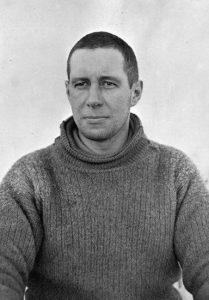Captain Lawrence “Titus” Oates (1880 – 1912)
 Captain Lawrence “Titus” Oates was a British army officer, and later an Antarctic explorer, who accompanied Captain Robert Scott to the South Pole during the Terra Nova Expedition. On the return journey Oates, afflicted with gangrene and frostbite, walked from his tent into a blizzard, hoping to improve his companions’ chances of survival.
Captain Lawrence “Titus” Oates was a British army officer, and later an Antarctic explorer, who accompanied Captain Robert Scott to the South Pole during the Terra Nova Expedition. On the return journey Oates, afflicted with gangrene and frostbite, walked from his tent into a blizzard, hoping to improve his companions’ chances of survival.
Early Life
Lawrence Oates was born into a wealthy British family and joined the military as a young man. He saw active service during the Boer War and later served in Ireland, Egypt, and India. His friends often called him “Titus Oates”, after an English historical figure.
The Terra Nova Expedition
In 1910, he applied to join Robert Falcon Scott’s expedition to the South Pole. He was accepted due to his experience with horses and his ability to make a financial contribution towards the expedition. Unfortunately Scott did not send Oates to Siberia to acquire the ponies, despite this being his area of expertise. When he first saw them he was horrified, noting they were too old for the job and ‘a wretched load of crocks.’ Oates’ role on was to look after the ponies and to get them and the supplies they hauled, to the foot of the Beardmore Glacier. He worked tirelessly, missing many meals and many hours of sleep, tending to the beasts during the frequent bouts of severe weather.
Oates disagreed with Scott many times on issues of management of the expedition. He commented on Scott’s ignorance about marching with animals and wrote in his diary,
‘Myself, I dislike Scott intensely and would chuck the whole thing if it were not that we are a British expedition…He is not straight, it is himself first, the rest nowhere …’
For his part, Scott called Oates ‘the cheery old pessimist’ and wrote,
‘The Soldier takes a gloomy view of everything, but I’ve come to see that this is a characteristic of him.’
Despite their differences, and despite the fact that Oates walked with a heavy limp (the result of a war wound), Scott eventually selected Oates as one of the five-man party who would travel the final distance to the Pole.
South Polar Journey
Captain Scott, Captain Oates and 14 other members of the expedition set off from their Cape Evans base camp for the South Pole on November 1, 1911. At various pre-determined latitude points during the 895-mile (1,440 km) journey, the support members of the expedition were sent back by Scott in teams until on January 4, 1912, only the five-man polar party of Scott, Edward A. Wilson, Henry R. Bowers, Edgar Evans and Oates remained to walk the last 167 miles (269 km) to the Pole. On January 17, 1912, 79 days after starting their journey, they finally reached the Pole only to discover that Norwegian explorer Roald Amundsen and his four-man team had beat them in the race to be first to the Pole. Amundsen had left a tent with a note inside, informing them that his party had reached the South Pole on December 14, 1911, beating Scott’s party by 35 days. Oates commended Amundsen’s team: ‘I must say that man must have had his head screwed on right. The gear they left was in excellent order and they seem to have had a comfortable trip with their dog teams, very different from our wretched man-hauling.
The Return Journey
Scott’s party faced extremely difficult conditions on the return journey. On February 17, 1912, near the foot of the Beardmore glacier, Edgar Evans died. Oates’ feet had become severely frostbitten and he was weakening faster than the rest. On March 5 Scott wrote in his diary, ‘Oates’ feet are in a wretched condition … The poor soldier is very nearly done.’ Oates’ slower progress was causing the party to fall behind schedule and run short on food. Their pre-laid depots each provided a week’s food and fuel, but they were unable to cover the required 9 miles (14 km) per day to have full rations. On March 15, Oates told his companions that he could not go on. He suggested that they leave him in his sleeping-bag, but they refused to do so. He managed a few more miles that day but his condition worsened that night.
Oates Death
On the morning of March 16, Oates walked out of the tent into a −40 °F (−40 °C) blizzard to his death. According to Scott’s diary, as Oates left the tent he said, ‘I am just going outside and may be some time’. Scott, Wilson and Bowers continued onwards for a further 20 miles (32 km) towards the ‘One Ton’ food depot but were halted by a fierce blizzard. They died nine days later, eleven miles short of their objective. Their frozen bodies were discovered by a search party the following spring; Oates’ body was never found. Near where he was presumed to have died, the search party erected a cairn and cross bearing the inscription;
‘Hereabouts died a very gallant gentleman, Captain L. E. G. Oates, of the Inniskilling Dragoons. In March 1912, returning from the Pole, he walked willingly to his death in a blizzard, to try and save his comrades, beset by hardships.’



